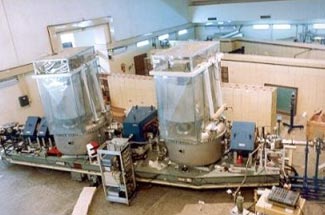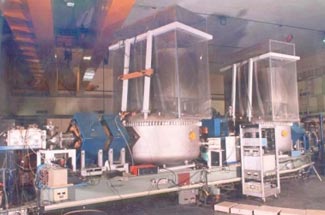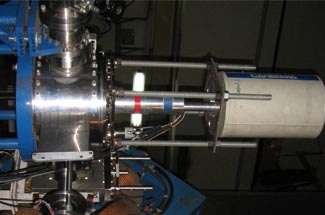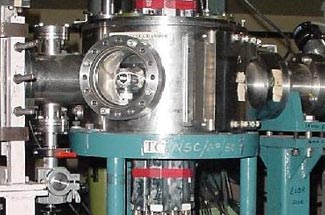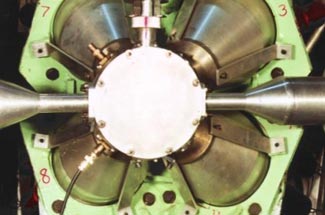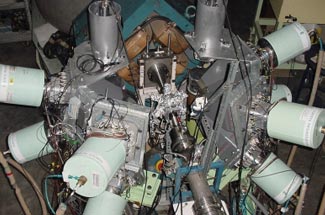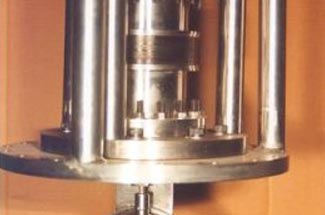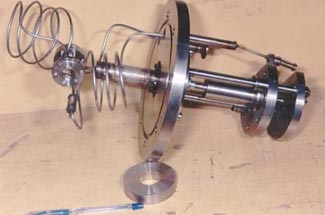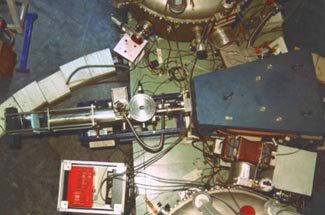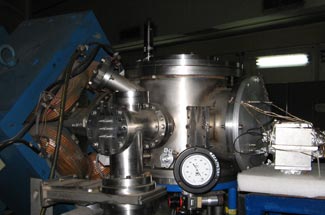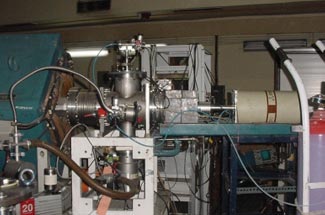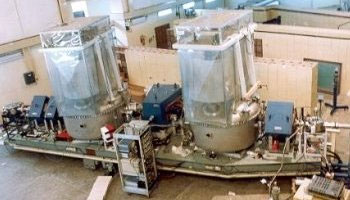
About Heavy Ion Reaction Analyzer
Heavy Ion Reaction Analyzer (HIRA) is one of few recoil mass spectrometers (RMS) in the world and first of its kind in Asia. HIRA is dedicated to the study of heavy ion induced nuclear reaction dynamics and can operate in the direction of primary beam. Efficient rejection of primary beam and transportation of reaction products to the focal plane with mass identification are the forte of HIRA. It is based on symmetric [electrostatic dipole]-[magnetic dipole]-[electrostatic dipole] (ED-MD-ED) configuration (first used in Rochester RMS design), with two quadrupole doublets placed before and after the first and last electrostatic dipoles. Space focus (in both dispersive and non-dispersive planes) and energy achromaticity are obtained at the focal plane with variable mass dispersion. The ion-optical parameters of ED-MD-ED combination of HIRA are unique and quite different from other existing recoil mass spectrometers.

In case of heavy ion induced complete fusion reactions in normal kinematics, HIRA rejects primary beam particles and multi-nucleon transfer reaction products, transports the evaporation residue to the focal plane and disperses them as per mass (m/q to be precise) values.
HIRA is being used for a wide variety of nuclear physics experiments exploiting its ability to study weak reaction channels at forward angles
- Heavy ion-induced fusion and transfer reactions around the Coulomb barrier
- Fission hindrance through spin dependence of heavy evaporation residues
- Residue-tagged γ-spectroscopy
- Residue-tagged light charged particle and neutron emission
- Microsecond isomer decay at the focal plane
- Experiments with secondary beam (7Be) produced in HIRA
HIRA has also been used, in mass focus ion optical mode, for the production of ultra-pure, low energy 7Be beam
HIRA, operated in mass achromatic mode with important add-ons, has been shown to deliver light radioactive ion beam of excellent purity and moderate intensity using (p,n), (d,n) type of reactions in inverse kinematics and in-flight technique. Primary beams of stable, light nuclei from the 15 UD Pelletron accelerator are used on hydrogenous target and the radioactive secondary particles are separated in-flight and re-focused at a secondary target position using the existing recoil mass spectrometer, HIRA, operated in a new ion-optical mode. To satisfy the ion-optical requirement of a well defined beam spot-size, polyethylene foil targets mounted on a rotary/linear motion device are used. In the new optics, there is a momentum dispersed focal plane at the center of the magnetic dipole. A slit system with in-vacuum transfer option is installed at this focal plane, to selectively transmit secondary radioactive particles of specific energy window to the final focal plane. The large energy and momentum dispersion achieved till the centre of MD helps in high selectivity of the secondary particles. The second half of HIRA cancels the energy and momentum dispersion resulting in excellent secondary beam quality at the focal plane. The four quadrupoles help in achieving good focus of selected particles at MD centre and at the focal plane.
We have optimized the facility for production of 7Be beam using the p(7Li,7Be)n reaction, with the following features:
- Beam energy: 16 - 22 MeV
- Beam intensity: ~ 104 pps
- Diameter of beam spot: 3 mm (FWHM) - depends on primary beam size
- Purity of beam: > 99%
- Energy spread: ± 0.5 MeV
- Angular spread: ± 20 mrad
The focal plane chamber of HIRA acts as the scattering chamber for reactions with secondary beam. It houses "triple axis movement" collimator as well as the detector set-up. Since its commissioning, the facility has been used to carry out a number of low energy nuclear reactions using 7Be secondary beam.
Features
Important specifications
Acceptance: 1-10 msr (variable)
Mass dispersion: 0-10 mm/% (variable)
Energy acceptance: ± 20%
Mass acceptance: ± 5%
Mass resolution: 1/300 (typical)
Total length: ~ 8.8 m
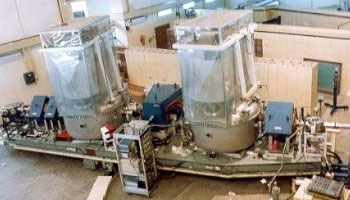
Reduction of higher order aberrations
A compact multipole, placed between ED1 and MD, with quadrupole, sextupole and octupole windings (in one plane) helps in reducing angle and energy dependent aberrations and in achieving energy achromatism at the focal plane. Suitable sextupole and octupole fields are super-imposed on the quadrupole field in Q4 by pole face shifts to reduce the mass-dependant 'focal plane tilt/curvature' aberration.
Slot in ED1 for better beam rejection
HIRA is the first RMS to allow provision to take the primary beam out without allowing it to scatter from the anode of the first electrostatic dipole. This is achieved by a horizontal slot (of 15 mm) cut out at the centre of the second half of the anode plate in ED1. This slot allows scattered beam particles to be collected on a beam catcher behind ED1 thereby reducing the background at the focal plane. The field non-uniformity is minimised by the use of special "rose-shim" profile around the periphery of the slot. Beam rejection factor achievable in HIRA is of the order of 1013 which depends on the reaction and to some extent on primary beam tuning. The beam catcher current signal (with ED1 voltages off) and the ratio of left and right monitor detectors along with the BPM signal (upstream of target) help in optimising and reproducing the primary beam trajectory.
Rotation of HIRA
The entire spectrometer is mounted on a platform which can rotate, about the vertical axis passing through the target and beam axis on a curved monorail (levelled to better than 0.1 mm), with the help of a motor. The angular scale is graduated with a least count of 0.1o (corresponding to ~ 1 cm arc at a distance ~ 5.7 metres). This option is particularly useful for measuring evaporation residue angular distribution and transfer products around the grazing angle.
Target chambers and accessories
HIRA is provided with a sliding seal chamber (300 mm inner diameter) which allows rotation of HIRA with respect to the beam direction by large angles (upto 25o) without disturbing chamber vacuum (~ 10-7 Torr). The sliding seal chamber is provided with option to mount a charge reset foil 10 cm downstream of target and monitor detectors at various angles. Two re-entrant cups allow mounting of HPGe detectors at close proximity (~ few cm away) of the target. Large re-entrant cups, replacing top and bottom lids, allow mounting of larger detectors such as BGO multiplicity filter and/or large scintillator detectors. A small aluminium chamber with conical entrance and exit coulplings is used in place of the sliding seal chamber during residue-tagged γ-spectroscopy and γ-multiplicity measurements.
Swivel stands for γ-detectors
Two swivel stands are installed on either side of the beam-line, around the target chamber, where upto eight HPGe detectors (four on either side) can be mounted. Large detector holders are also available for the swivel stands in which eight Clover detectors and four HPGe or neutron detectors can be mounted.
Focal plane detectors
A variety of detectors are available to be used at the focal plane of HIRA. The choice of detectors is guided by the type and energy of the particles and also the underlying physics interest. The most common detectors in use are:
- 2D position sensitive, large area, Multi-wire proportional counter
- Deep, split-anode, Ionization chamber and
- 2D position sensitive, 50mm x 50mm, silicon detector.
For more information on detectors, please contact: Detector laboratory.
Research
- Heavy ion-induced fusion and transfer reactions around the Coulomb barrier
- Fission hindrance through spin dependence of heavy evaporation residues
- Residue-tagged γ-spectroscopy
- Residue-tagged light charged particle and neutron emission
- Microsecond isomer decay at the focal plane
- Experiments with secondary beam (7Be) produced in HIRA
People
Staff Telephone: +91 11 24126018, 24126022, 24126024-26, 24126029 Telefax: +91 11 24126036, 24126041
Research Scholars (Pursuing and beam time taken)
-
Visakh A. C.
Central University of Kerala, Kasaragod, Kerala
-
Amit Chouhan
IIT Roorkee, Roorkee
-
N. K. Deb
UGC-DAE, CSR, Kolkata Centre, Kolkata, India
-
N. K. Ghosh
Karnatak University, Dharwad, India
-
G. Naga JyothiG. Naga Jyothi
Andhra University, Visakhapatnam, India
-
A. Tejaswi
Andhra University, Visakhapatnam, India
-
P. Jisha
Calicut University, Calicut, Kerala
-
Amarnadh R. U.
University College, Thiruvanantapuram
Alumni
-
R. N. Sahoo
IIT Ropar, Rupnagar, Punjab
-
Deepak Kumar
IIT Roorkee, Roorkee
-
Khushboo
Delhi University, Delhi, India
-
T. Rajbongshi
Gauhati University, Guwahati, India
-
M. Kaur
Panjab University, Chandigarh, India
-
Sunil Kalkal
Delhi University, Delhi, India
-
R. Kumar
Panjab University, Chandigarh, India
-
S. Verma
Delhi University, Delhi, India
-
P. D. Shidling
Karnatak University, Dharwad, India
-
K. Kalita
Delhi University, Delhi, India
-
P. Das
Variable Energy Cyclotron Centre, Kolkata, India
-
S. Barua
Gauhati University, Guwahati, India
-
A. Chakrabarty
UGC-DAE, CSR, Kolkata Centre, Kolkata, India
-
P. V. Madhusudhana Rao
Andhra University, Visakhapatnam, India
-
S. K. Tandel
Mumbai University, Mumbai, India
-
V. Tripathi
Inter-University Accelerator Centre, New Delhi, India
-
Lagy T. Baby
Bangalore University, Bangalore, India
-
R. Singh
Panjab University, Chandigarh, India
-
N. Panchasara
Saurashtra University, Rajkot, India
-
S. K. Hui
Calcutta University, Kolkata, India
-
K. G. Chhaya
Saurashtra University, Rajkot, India
-
A. M. Vinod Kumar
Calicut University, Calicut, India
-
N. V. S. V. Prasad
Andhra University, Visakhapatnam, India
Publication
-
Evaporation residue measurements of compound nuclei in the A ≈ 200 region
P. Jisha, A. M. Vinodkumar, B. R. S. Babu, S. Nath, N. Madhavan, J. Gehlot, A. Jhingan, T. Banerjee, Ish Mukul, R. Dubey, N. Saneesh, K. M. Varier, E. Prasad, A. Shamlath, P. V. Laveen, and M. Shareef Phys. Rev. C 101, 024611 (2020)
-
Simulation of a recoil mass spectrometer for measurementof differential quasi-elastic scattering cross sections
Rohan Biswas, S. Nath Eur. Phys. J. A (2020) 56:1
Search for stabilizing effects of the Z = 82 shell closure against fission
J. Gehlot, S. Nath, Tathagata Banerjee, Ish Mukul, R. Dubey, A. Shamlath, P. V. Laveen, M. Shareef, Md. Moin Shaikh, A. Jhingan, N. Madhavan, Tapan Rajbongshi, P. Jisha, and Santanu Pal Phys. Rev. C 99, 061601(R) (2019)
Searching the reason for sub-barrier fusion enhancement through multineutron transfer channels
Khushboo, N. Madhavan, S. Nath, A. Jhingan, J. Gehlot, B. Behera, S. Verma, S. Kalkal, and S. Mandal Phys. Rev. C 100, 064612 (2019)
Sub-barrier fusion in the
37Cl +130Te system Rudra N. Sahoo, Malika Kaushik, Arshiya Sood, Pawan Kumar, Arzoo Sharma, Swati Thakur, Pushpendra P. Singh, P. K. Raina, Md. Moin Shaikh, Rohan Biswas, Abhishek Yadav, J. Gehlot, S. Nath, N. Madhavan, V. Srivastava, Manoj K. Sharma, B. P. Singh, R. Prasad, Anjali Rani, A. Banerjee, Unnati Gupta, Nabendu K. Deb, and B. J. Roy, Phys. Rev. C 99, 024607
Investigation of fusion hindrance in a soft asymmetric system deep below the barrier
M. M. Shaikh, S. Nath, J. Gehlot, T. Banerjee, I. Mukul, R. Dubey, A. Shamlath, P. V. Laveen, M. Shareef, A. Jhingan, N. Madhavan, T. Rajbongshi, P. Jisha, G. Naga Jyothi, A. Tejaswi, R. N. Sahoo, and A. Rani, J. Phys. G: Nucl. Part. Phys. 45, 195103 (2018)
Relationship between and effect of inelastic excitations and transfer channels on sub-barrier fusion enhancement
Khushboo, S. Mandal, S. Nath, N. Madhavan, J. Gehlot, A. Jhingan, N. Kumar, T. Banerjee, G. Kaur, K. R. Devi, A. Banerjee, Neelam, T. Varughese, D. Siwal, R. Garg, I. Mukul, M. Saxena, S. Verma, S. Kumar, B. R. Behera, and P. Verma Phys. Rev. C 96, 014614 (2017).
Influence of neutron transfer channels on fusion enhancement in sub-barrier region
Khushboo, S. Mandal, N. Madhavan, S. Muralithar, J. J. Das, S. Nath, A. Jhingan, J. Gehlot, B. Behera, S. Verma, H. Singh, S. Kalkal, and R. Singh EPJ Web of Conferences 163, 00029 (2017)
Deformation effects on sub barrier fusion cross sections in 16O+174,176Yb
Tapan Rajbongshi, K. Kalita, S. Nath, J. Gehlot, Tathagata Banerjee, Ish Mukul, R. Dubey, N. Madhavan, C. J. Lin, A. Shamlath, P. V. Laveen, M. Shareef, Neeraj Kumar, P. Jisha, and P. Sharma Phys. Rev. C 93, 054622 (2016)
Probing dynamics of fusion reactions through cross-section and spin distribution measurement
Maninder Kaur, B.R. Behera, Gulzar Singh, Varinderjit Singh, N. Madhavan, S. Muralithar, S. Nath, J. Gehlot, G. Mohanto, Ish Mukul, D. Siwal, M. Thakur, K. Kapoor, P. Sharma, T. Banerjee, A. Jhingan, T. Varughese, Indu Bala, B.K. Nayak, A. Saxena, M.B. Chatterjee and P.D. Stevenson EPJ Web of Conferences 117 , 08026 (2016)
Spin distribution as a probe to investigate the dynamical effects in fusion reactions
Maninder Kaur, B.R. Behera, Gulzar Singh, Varinderjit Singh, N. Madhavan, S. Muralithar, S. Nath, J. Gehlot, G. Mohanto, Ish Mukul, Davinder Siwal, Meenu Thakur, Kushal Kapoor, Priya Sharma, Akhil Jhingan, T. Varughese, Indu Bala, M.B. Chatterjee, B.K. Nayak and A. Saxena EPJ Web of Conferences 86 , 00026 (2015)
Anomalous deviations from statistical evaporation spectra for the decay of the 73Br and 77Rb compound systems
Maninder Kaur, B. R. Behera, Gulzar Singh, Varinderjit Singh, Rohit Sandal, A. Kumar, H. Singh, Gurpreet Singh, K. P. Singh, N. Madhavan, S. Nath, A. Jhingan, J. Gehlot, K. S. Golda, P. Sugathan, Davinder Siwal, Sunil Kalkal, E. Prasad, and S. Appannababu Phys. Rev. C 89, 034621 (2014)
Measurements and coupled reaction channels analysis of one- and two-proton transfer reactions for the 28Si + 90,94Zr systems
Sunil kalkal, S. Mandal, A. Jhingan, J. Gehlot, P. Sugathan, K. S. Golda, N. Madhavan, Ritika Garg, Savi Goyal, Gayatri Mohanto, Rohit Sandal, Santosh Chakraborty, Sashi Verma, Bivash Behera, G. Eleonora, H. J. Wollersheim, and R. Singh Phys. Rev. C 85, 034606 (2012)
Multinucleon transfer reactions for the 28Si + 90,94Zr systems in the region below and near the Coulomb barrier,
Sunil Kalkal, S. Mandal, N. Madhavan, A. Jhingan, E. Prasad, Rohit Sandal, S. Nath, J. Gehlot, Ritika Garg, Gayatri Mohanto, Mansi Saxena, Savi Goyal, S. Verma, B.R. Behera, Suresh Kumar, U.D. Pramanik, A.K. Sinha, R. Singh, Phys. Rev. C 83 (2011) 054607.
Reconstruction of γ-multiplicity distribution from a finite number of its moments,
S. Nath, Nucl. Instr. and Meth. A 640 (2011) 225.
sion and transfer reactions around the Coulomb barrier for 28Si + 90,94Zr systems
Sunil Kalkal, S. Mandal, N. Madhavan, A. Jhingan, E. Prasad, Rohit Sandal, J. Gehlot, S. Verma, Ritika Garg, Savi Goyal, Mansi Saxena, S. Nath, Bivash Behera, Suresh Kumar, U.D. Pramanik, Davinder Siwal, Gayatri Mohanto, H.J. Wollersheim, A.K. Sinha and R Singh, Journal of Physics: Conference Series 312 (2011) 082027.
Angular momentum distribution for the formation of evaporation residues in fusion of 19F with 184W near the Coulomb barrier
S. Nath, J. Gehlot, E. Prasad, Jhilam Sadhukhan, P.D. Shidling, N. Madhavan, S. Muralithar, K.S. Golda, A. Jhingan, T. Varughese, P.V. Madhusudhana Rao, A.K. Sinha and Santanu Pal, Nucl. Phys. A 850 (2011) 22.
Erratum to ``TERS v2.0: An improved version of TERS'' [Comput. Phys. Commun. 180 (2009) 2392],
S. Nath, Comput. Phys. Commun. 181 (2010) 1659.
Evaporation residue excitation function from complete fusion of 19F with 184W
S. Nath, P.V. Madhusudhana Rao, Santanu Pal, J. Gehlot, E. Prasad, Gayatri Mohanto, Sunil Kalkal, Jhilam Sadhukhan, P.D. Shidling, K.S. Golda, A. Jhingan, N. Madhavan, S. Muralithar, A.K. Sinha, Phys. Rev. C 81 (2010) 064601.
Channel coupling effects on the fusion excitation functions for 28Si+90,94Zr in sub- and near-barrier regions,
Sunil Kalkal, S. Mandal, N. Madhavan, E. Prasad, Shashi Verma, A. Jhingan, Rohit Sandal, S. Nath, J. Gehlot, B.R. Behera, Mansi Saxena, Savi Goyal, Davinder Siwal, Ritika Garg, U.D. Pramanik, Suresh Kumar, T. Varughese, K.S. Golda, S. Muralithar, A.K. Sinha, R. Singh, Phys. Rev. C 81 (2010) 044610.
Interaction of loosely bound radioactive 7Be and stable 7Li with 9Be
S. Verma, J.J. Das, A. Jhingan, K. Kalita, S. Barua, K.S. Golda, N. Madhavan, P. Sugathan, S. Nath, T. Varughese, J. Gehlot, S. Mandal, Ranjit, P.K. Sahu, B. John, B.K. Nayak, V. Jha, A. Saxena, S.K. Datta, R. Singh, Eur. Phys. J. A 44 (2010) 385.
TERS v2.0: An improved version of TERS,
S. Nath, Comput. Phys. Commun. 180 (2009) 2392.
Experimental signature of entrance channel effect in heavy mass region via evaporation residue cross section and spin distribution measurements
P.D. Shidling, N. Madhavan, V.S. Ramamurthy, S. Nath, N.M.Badiger, Santanu Pal, A.K. Sinha, A. Jhingan, S. Muralithar, P. Sugathan, S. Kailas, B.R. Behera, R. Singh, K.M. Varier, M.C.Radhakrishna, Phys. Lett. B 670 (2008) 99.
A Monte Carlo C-code for calculating transmission efficiency of recoil separators and viewing residue trajectories
S. Nath, Comp. Phys. Comm. 179 (2008) 492.
A Monte Carlo code to calculate transmission efficiency of HIRA
S. Nath, Nucl. Instr. and Meth. A 576 (2007) 403.
Measurements of elastic scattering for 7Be,7Li+9Be systems and fusion cross sections for 7Li+9Be system
S. Verma, J.J. Das, A. Jhingan, K. Kalita, S. Barua, K.S. Golda, N. Madhavan, P. Sugathan, S. Nath, T. Varughese, J. Gehlot, S. Mandal, S. Ranjit, P.K. Sahu, B. John, B.K. Nayak, A. Saxena, S.K. Datta, R. Singh, Eur. Phys. Journal Special Topics 150 (2007) 75.
Fission Hindrance studies in 200Pb: Evaporation residue cross-section and spin distribution measurements
P. D. Shidling, N. M.Badiger, S. Nath, R. Kumar, A. Jhingan, R. P. Singh, P. Sugathan, S.Muralithar, N. Madhavan, A. K. Sinha, S. Pal, S. Kailas, S. Verma, K.Kalita, S. Mandal, R. Singh, B. R. Behera, K. M. Varier, M. C.Radhakrishna, Phys. Rev. C 74 (2006) 064603.
Change of 7Be decay rate in exohedral and endohedral C60 fullerene compounds and its implications
A. Ray, P. Das, S.K. Saha, S.K. Das, J.J. Das, N. Madhavan, S. Nath, P. Sugathan, P.V.M. Rao, and A. Jhingan, Phys. Rev. C 73 (2006) 034323.
Elastic scattering and fusion cross sections for 7Be,7Li+27Al systems
K. Kalita, S. Verma, R. Singh, J.J. Das, A. Jhingan, N. Madhavan, S. Nath, T. Varughese, P. Sugathan, V.V. Parkar, K. Mahata, K. Ramachandran, A. Shrivastava, A. Chatterjee, S. Kailas, S. Barua, P. Basu, H. Majumdar, M. Sinha, R. Bhattacharya, A.K. Sinha, Phys. Rev. C 73 (2006) 024609.
Astrophysical S17(0) factor from a measurement of the 2H(7Be, 8B)n reaction at Ec.m. = 4.5 MeV
J.J. Das, V.M. Datar, P. Sugathan, P.V. Madhusudhana Rao, A. Jhingan, A. Navin, S.K. Dhiman, S. Barua, S. Nath, T. Varughese, A.K. Sinha, R. Singh, A. Ray, D.L. Sastry, R.G. Kulkarni, R. Shyam, Phys. Rev. C 73 (2006) 015808.
Spectroscopy of 90Nb at high spin
A. Chakraborty, Krishichayan, S.S. Ghugre, R. Goswami, S. Mukhopadhyay, N.S. Pattabiraman, S. Ray, A.K. Sinha, S. Sarkar, P.V.M. Rao, U. Garg, S.K. Basu, M.B. Chatterjee, M.S. Sarkar, L. Chaturvedi, A. Dhal, R.K. Sinha, I.M. Govil, R.K. Bhowmik, A. Jhingan, N. Madhavan, S. Muralithar, S. Nath, R.P. Singh, P. Sugathan, Phys.Rev. C 72 (2005) 054309.
Investigation of scattering between mirror nuclei 7Be and 7Li
S. Barua, J.J. Das, A. Jhingan, N. Madhavan, T. Varughese, P. Sugathan, K. Kalita, S. Verma, B. Bhattacharjee, S.K. Datta, K. Boruah, Phys. Rev. C 72 (2005) 044602.
Development of a large area telescopic detector system for elastic and transfer reaction angular distribution measurements
K. Kalita, A. Jhingan, S. Barua, J.J. Das, T. Varughese, P. Sugathan, N. Madhavan, S. Nath, S. Verma and R. Singh, Indian Journal of Pure and Applied Physics 43 (2005) 573.
Production of light radioactive ion beams (RIB) using inverse kinematics
J.J. Das, P. Sugathan, N. Madhavan, P.V. Madhusudhana Rao, A. Jhingan, T. Varughese, S. Barua, S. Nath, A.K. Sinha, B. Kumar and J. Zacharias, Nucl. Instr. and Meth. B 241 (2005) 953.
Lifetime measurements of microsecond isomers in the N = 48 nuclei 88Zr and 90Mo using recoil-isomer tagging,
A. Chakraborty, Krishichayan, S.S. Ghugre, R. Goswami, S. Mukhopadhyay, N.S. Pattabiraman, S. Ray, A.K. Sinha, S. Sarkar, P.V.M. Rao, U. Garg, S.K. Basu, L. Chaturvedi, A. Dhal, R.K. Sinha, I.M. Govil, M.B. Chatterjee, M.S. Sarkar, R.K. Bhowmik, A. Jhingan, N. Madhavan, S. Muralithar, S. Nath, R.P. Singh, P. Sugathan, Phys.Rev. C 70 (2004) 014311.
A new measurement of d(7Be, 8B)n reaction at Ec.m. = 4.5 MeV for the extraction of S17(0) factor using ANC method
J.J. Das, V.M. Datar, P. Sugathan, N. Madhavan, P.V. Madhusudhana Rao, A. Jhingan, A. Navin, S.K. Dhiman, S. Barua, S. Nath, T. Varughese, A.K. Sinha, R. Singh, A. Ray, D.L. Sastry, R.G. Kulkarni, R. Shyam, Nucl. Phys. A 746 (2004) 561c.
Study of elastic scattering of mirror nuclei 7Be + 7Li
S. Barua, J.J. Das, A. Jhingan, T. Varughese, N. Madhavan, P. Sugathan, S. Verma, K. Kalita, B. Bhattacharjee, S.K. Datta, K. Boruah, Nucl. Phys. A 746 (2004) 467c.
A new detector system for radioactive ion beam experiments at the focal plane of the recoil mass spectrometer HIRA at NSC
Akhil Jhingan, P. Sugathan, S. Barua, J.J. Das, T. Varughese, N. Madhavan, S. Nath, P.V. Madhusudhana Rao, Nucl. Instr. and Meth. A 526 (2004) 376.
Rotating target facility for in-flight radioactive ion beam production using a recoil mass spectrometer
T. Varughese, J.J. Das, N. Madhavan, P. Sugathan, P.V. Madhusudhana Rao, A. Jhingan, S. Nath, A.K. Sinha, J. Zacharias, Nucl. Instr. and Meth. A 521 (2004) 143.
The present and planned recoil mass spectrometers at Nuclear Science Centre, New Delhi
S. Nath, A. Jhingan, T. Varughese, J.J. Das, P. Sugathan, N. Madhavan, R. Kumar, R.P. Singh, S. Muralithar, R.K. Bhowmik, A.K. Sinha, Yadernaya Fizika 66 (2003) 1567; Physics of Atomic Nuclei 66 (2003) 1523.
Status of measurement of 7Be(d, n)8B reaction to determine the astrophysical S17(0) factor using ANC method,
J.J. Das, V.M. Datar, P. Sugathan, N. Madhavan, P.V. Madhusudhana Rao, A. Navin, T. Varughese, A. Jhingan, S. Nath, A. Ray, S. Barua, A.K. Sinha, J. Zacharias, R. Singh, R. Shyam, S.K. Dhiman, R.G. Kulkarni, and D.L. Sastry, Indian Journal of Physics 76 (2002) 133.
Isotopic dependence and channel coupling effects in the fusion of 16O + 112,116Sn and 32S + 112,116,120Sn at energies around the barrier
Vandana Tripathi, Lagy T. Baby, J.J. Das, P. Sugathan, N. Madhavan, A.K. Sinha, P.V. Madhusudhana Rao, S.K. Hui, R. Singh, K. Hagino, Phys. Rev. C 65 (2001) 014614.
Development of low energy radioactive ion beam facility at NSC
J J Das, P Sugathan, N Madhavan, T Varughese, P V Madhusudhana Rao, J Zacharia, Akhil Jhingan, Subir Nath, A K Sinha and R Singh, Indian Journal of Pure and Applied Physics 39 (2001) 20.
Spin and excitation energy dependence of fission survival for the 19F + 175Lu system
S.K. Hui, C.R. Bhuinya, A.K. Ganguly, N. Madhavan, J.J. Das, P. Sugathan, D.O. Kataria, S. Muralithar, Lagy T. Baby, Vandana Tripathi, Akhil Jhingan, A.K. Sinha, P.V. Madhusudhana Rao, N.V.S.V. Prasad, A.M. Vinod Kumar, R. Singh, M. Thoennessen, and G. Gervais, Phys. Rev. C 62 (2000) 054604.
Role of 28Si excitations in the sub-barrier fusion of 28Si +120Sn
Lagy T. Baby, Vandana Tripathi, J.J. Das, P. Sugathan, N. Madhavan, A.K. Sinha, M.C. Radhakrishna, P.V. Madhusudhana Rao, S.K. Hui, and K. Hagino, Phys. Rev. C 62 (2000) 014603.
High spin states in 70Ge
B. Mukherjee, S. Muralithar, G. Mukherjee, R.P. Singh, R. Kumar, J.J. Das, P. Sugathan, N. Madhavan, P.V. Madhusudhana Rao, A.K. Sinha, A.K. Pande, L. Chaturvedi, S.C. Pancholi and R.K. Bhowmik, Heavy Ion Physics 11 (2000) 189.
Ion-optics of the radioactive ion beam facility at NSC
J.J. Das, P. Sugathan, N. Madhavan, P.V. Madhusudanan Rao, T. Varughese, B. Kumar and A.K. Sinha, Indian Journal of Physics 73S (1999) 136.
Transfer measurements for the Ti + Ni systems at near barrier energies
K.M. Varier, A.M. Vinodkumar, N.V.S.V. Prasad, P.V. Madhusudhana Rao, D.L. Sastry, Lagy T. Baby, M.C. Radhakrishna, N.G. Puttaswamy, J.J. Das, P. Sugathan, N. Madhavan, A.K. Sinha and D.O. Kataria, Pramana - Journal of Physics 53 (1999) 167.
Measurement of ground state 2n pickup probability for 28Si + 68Zn
Vandana Thripathi, Lagy T. Baby, P.V. Madhusudhana Rao, S.K. Hui, R. Singh, J.J. Das, P. Sugathan, N. Madhavan and A.K. Sinha, Pramana - Journal of Physics 53 (1999) 173.
Development of radioactive ion beam facility using 15UD tandem accelerator at NSC
J.J. Das, P. Sugathan, N. Madhavan, B. Kumar, T. Varughese, P.V. Madhusudhana Rao and A.K. Sinha, Journal of Physics: G 24 (1998) 1371.
Alpha- particle emission as a probe of dynamical deformations
I.M. Govil, R. Singh, A. Kumar, J. Kaur, A.K. Sinha, N. Madhavan, D.O. Kataria, P. Sugathan, S.K. Kataria, K. Kumar, Bency John and G.V. Ravi Prasad, Phys. Rev. C 57 (1998) 1269.
Sub-barrier few-nucleon transfer reaction and channel coupling effects in heavy ion fusion
A.K. Sinha in collaboration with L.T. Baby, N. Badiger, J.J. Das, S.K. Hui, D.O. Kataria, R.G. Kulkarni, N. Madhavan, P.V. Madhusudhana Rao, I. Mazumdar, M.C. Radhakrishna, N.V.S.V. Prasad, N.G. Prasad, P. Shakeeb, R. Singh, D.L. Sastry, P. Sugathan, V. Thripathi, K.M. Varier and A.M. Vinodkumar, Journal of Physics: G 23 (1997) 1331.
Identification of Δν=2 identical bands in the nuclei 78Kr and 80Rb system
S.K. Tandel, S.B. Patel, R.K. Bhowmik, A.K. Sinha, S. Muralithar, N. Madhavan, Phys. Rev. C 56 (1997) R2358.
Transfer and higher order phonon coupling effects in the sub-barrier fusion of 28Si and 93Nb system
L.T. Baby, Vandana Tripathi, D.O. Kataria, J.J. Das, P. Sugathan, N. Madhavan, A.K. Sinha, M.C. Radhakrishna, N.M. Badiger, N.G. Puttaswamy, A.M Vinodkumar and N.V.S.V. Prasad, Phys. Rev. C 56 (1997) 1936.
One and two nucleon transfer in the 28Si and 68Zn system at energies below the Coulomb barrier
D.O. Kataria, A.K. Sinha, J.J. Das, N. Madhavan, P. Sugathan, Lagy T. Baby, I. Mazumdar, R. Singh, C.V.K. Baba, Y.K. Agarwal, A.M Vinodkumar and K.M. Varier, Phys. Rev. C 56 (1997) 1902
Study of transfer channel coupling and entrance channel effects for the near and sub-barrier fusion of 46Ti + 64Ni, 50Ti + 60Ni and 19F + 93Nb systems
N.V.S.V. Prasad, A.M. Vinodkumar, A.K. Sinha, K.M. Varier, D.L. Sastry, N. Madhavan, P. Sugathan, D.O. Kataria, J.J. Das, Nucl. Phys. A 603 (1996) 176.
Absence of isotopic dependence in the sub-barrier fusion of 48Ti + 58,60,64Ni system
A.M. Vinodkumar, K.M. Varier, N.V.S.V. Prasad, D.L. Sastry, A.K. Sinha, N. Madhavan, P. Sugathan, D.O. Kataria, J.J. Das, Phys. Rev. C 53 (1996) 803.
A modular focal plane detector system for the Heavy Ion Reaction Analyzer at NSC, New Delhi
D.O. Kataria, J.J. Das, N. Madhavan, P. Sugathan, A.K. Sinha, G. Dayanand, M.C. Radhakrishna, A.M. Vinodkumar, K.M. Varier, M. Singh, N.V.S.V. Prasad, Nucl. Instr. and Meth. A 372 (1996) 311.
Calibration of analyzing magnet for beam energy measurement using recoil mass separator HIRA
N. Madhavan, J.J. Das, P. Sugathan, D.O. Kataria, D.K. Awasthi, A. Mandal and A. K. Sinha, Nucl. Instr. and Meth. A 370 (1996) 315.
Heavy ion reaction analyser (HIRA): a recoil mass separator facility at NSC
A.K. Sinha, N. Madhavan, J.J. Das, P.Sugathan, D.O. Kataria, A.P. Patro, G.K. Mehta, Nucl. Instr. and Meth. A 339 (1994) 543.








